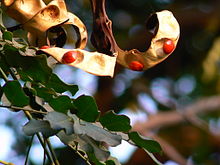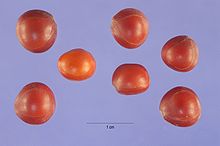- Adenanthera pavonina
-
Adenanthera pavonina 
Adenanthera pavonina with the red seeds, India. Scientific classification Kingdom: Plantae (unranked): Angiosperms (unranked): Eudicots (unranked): Rosids Order: Fabales Family: Fabaceae Genus: Adenanthera Species: A. pavonina Binomial name Adenanthera pavonina
L.Adenanthera pavonina is a species of tree, used for its timber, also known as Barbados pride, Coral-wood, Coralwood, Peacock flower fence, Red beadtree, Red sandalwood tree, Red sandalwood, Sandalwood tree, Saga; syn. Adenanthera gersenii Scheff., Adenanthera polita Miq., Corallaria parvifolia Rumph. The tree is common within the tropics of the old world. In India, each language has its own name fo the tree (for example in Kerala it is known as Manchadi). It is also introduced in the following countries of the Americas: Brazil, especially in Caatinga vegetation; Costa Rica, Honduras, Cuba, Jamaica, Puerto Rico, Trinidad, Tobago, Venezuela, and the United States, specially in southern Florida.
Contents
Alkaloids
Several alkaloids have been isolated from Adenanthera pavonina including pilocarpine, pilocarpidine and physostigmine.[citation needed]
Uses
This tree is useful for nitrogen fixation, and it is often cultivated for forage, as a medicinal plant, and as an ornamental garden plant and urban tree. The beauty of the seeds, their use as beads and for necklace, and their nourishing qualities (the raw seeds are toxic but can be eaten when cooked), have combined to scatter the plant. E. J. H. Corner states that in India, the seeds have been used as far back as history records as units of weight for fine measures, of gold for instance.[1] The Malay name for the tree, saga, has been traced to the Arabic for 'goldsmith'.
The small, yellowish flower grows in dense drooping rat-tail flower heads, almost like catkins. The curved hanging pods, with a bulge opposite each seed, split open each into two twisted halves to reveal the hard, scarlet seeds. The young leaves can be cooked and eaten. The wood, which is extremely hard, is used in boat-building, making furniture and for firewood.
This tree is used for making soap, [2] and a red dye can be obtained from the wood.
High doses of the seed extract show an anti-inflammatory effect in studies in rats and mice.[3]
References
- ^ E. J. H. Corner, "Wayside Trees of Malaya: Vol. I", Malayan Nature Society, 4th ed., 1997
- ^ Species used for Soap, Dr. Duke's Phytochemical and Ethnobotanical Databases
- ^ Olajide O.A., Echianu C.A., Adedapo A.D., Makinde J.M. (2004). "Anti-inflammatory studies on Adenanthera pavonina seed extract". Inflammopharmacology 12 (2): 196–202. doi:10.1163/1568560041352310. PMID 15265320.
External links
- International Legume Database & Information Service: Adenanthera pavonina
- Adenanthera pavonina
- USDA Plants Profile: Adenanthera pavonina
Categories:- Adenanthera
- Medicinal plants
- Trees of China
- Trees of India
- Flora of Indochina
- Flora of the Northern Territory
- Trees of Papua New Guinea
- Flora of Sri Lanka
- Fabaceae tree stubs
Wikimedia Foundation. 2010.

